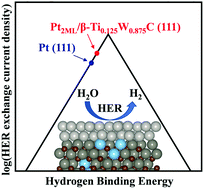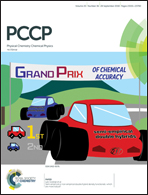Tuning core–shell interactions in tungsten carbide–Pt nanoparticles for the hydrogen evolution reaction†
Abstract
Platinum (Pt) is among the best electrocatalysts for the hydrogen evolution reaction (HER), a potentially fossil-free route for hydrogen production. Reduction in Pt loading and overall catalyst cost, without sacrificing catalytic activity, can be achieved by the synthesis of stable core–shell nanoparticles of transition-metal carbides and Pt. We employ density-functional theory (DFT) calculations to study and contrast the suitability of the α and β phases of tungsten carbide (WC) as support (core) materials for Pt shells. We examine the thermodynamic stability of 1–2 layers of Pt on α- and β-WC surfaces, carefully accounting for the delicate balance between epitaxial mismatch strains and chemical bonding between cores and shells. We also study the effects of alloying β-WC with Ti to modulate the stability and electronic structure of the core–shell structures. We compare the electronic structures of Pt overlayers supported on α-WC and β-TixW1−xC surfaces and compare their activities for HER using the hydrogen binding energy as a descriptor of catalytic activity. Our studies reveal that moderate Ti doping of the metastable β-WC phase significantly improves its stability and, with merely two layers of Pt loading, HER activity comparable or superior to Pt(111) can be attained. Overall, our results provide detailed insight into experimental observations of the excellent stability and high catalytic activity of β-TixW1−xC@Pt core–shell nanoparticles.

- This article is part of the themed collection: 2018 PCCP HOT Articles


 Please wait while we load your content...
Please wait while we load your content...